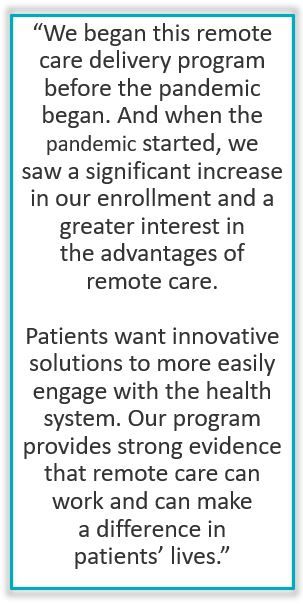- Clinical Technology
- Adult Immunization
- Hepatology
- Pediatric Immunization
- Screening
- Psychiatry
- Allergy
- Women's Health
- Cardiology
- Pediatrics
- Dermatology
- Endocrinology
- Pain Management
- Gastroenterology
- Infectious Disease
- Obesity Medicine
- Rheumatology
- Nephrology
- Neurology
- Pulmonology
Fully Remote Intervention for Hypertension, Lipids Proves Feasible, Successful in Large, Diverse Health Care Network

An exclusively remote program designed to expand access to hypertension and hypercholesterolemia management interventions is associated with significant reductions in blood pressure and LDL-C levels in a large, ethnically diverse health care network.
The findings, from a cohort study that included more than 10 000 participants with blood pressure (BP) and/or cholesterol above guideline-recommended targets, say study authors, support the feasibility of a standardized remote care delivery program to optimize guideline-directed therapy at scale, reduce cardiovascular (CV) risk, and minimize the need for in person visits among diverse populations.
Further, the program relied on nonlicensed navigators and pharmacists to coordinate and deliver interventions, amortizing the time and expertise of supervising licensend health care professionals, including cardiologists, across thousands of patient encounters.
“The findings in this study indicated an association between remote health delivery at scale and improvements in chronic disease metrics in a large urban and suburban outpatient cohort and across racial, ethnic, and language populations historically underserved by health care,” wrote investigators led by Alexander Blood, MD, MSc, from the Division of Cardiology at the Massachusetts General Hospital. “We believe that this program may serve as a model for health care professionals and systems aiming to enhance access, patient engagement, and health outcomes.”
“The findings in this study indicated an association between remote health delivery at scale and improvements in chronic disease metrics in a large urban and suburban outpatient cohort and across racial, ethnic, and language populations historically underserved by health care.”
STUDY DESIGN
Blood and colleauges recruited participants within the Massachusetts General Brigham (MGB) health care system who were between the ages of 26 and 80 years, had BP and/or LDL-C above guideline recommended targets and being monitored by a physician Qualified patients were subsequently contacted by a nonlicensed patient navigator to confirm eligibility and interest in participation.
Patient navigators are the primary point of contact with study participants, responsible for all communications, collecting data, and conveying all recommendations made by the clinical team (eg, on diet, lifestyle, medication) in an effort to optimize risk reduction for participants
All study participants received relevant education, integration of a home blood pressure device, and guidance on medication titration from the patient navigator team. Navigators receive supervision from a team of pharmacists, nurse practitioners, and cardiologists and coordinate patient care using standardized treatment algorithms, task management and automation software, and multimedia communication channels.
From January 1, 2018-July 1, 2021, researchers screened a total of 20 454 patients. Final enrollment was 10 803 participants—3658 enrolled in the hypertension program alone, 8103 in the cholesterol management program alone, and 958 in both.
Of note, a group of 1266 patients requested dietary, lifestyle and medication advice but declined participation in home BP monitoring and guidance on medication titration. This group was designated a nonrandomized concurrent control cohort and BP and LDL-C values were compared with those who did agree to medication management.
Mean age of the cohort was 65 years and 56% were women. Among them, 72% identified as White, 12% as Black, 11% as Hispanic, and 16% as another or multiple races. Overall, 11% of the population reported a preferred language other than English.
FINDINGS
During the study period the investigators collected a total of 424 482 blood pressure readings and 139 263 laboratory reports.
Before enrollment in the hypertension program, they report mean participant baseline office BP was 150/83 mm Hg and mean home BP was 145/83 mm Hg.
Study coauthor Benjamin Scirica, MD, MPH

Hypertension. Among the participants in the hypertension program who participated in remote medication management, the mean clinic SBP/DBP 6 months after enrollment decreased by 8.7/3.8 mm Hg and by 9.7/5.2 mm Hg at 12 months. Corresponding changes seen in the education-only group were a mean −1.5/−0.7 mm Hg at 6 months and +0.2/−1.9 mm Hg at 12 months (P <.001 for between cohort difference).
Hypercholesterolemia. In the lipids program, patients who chose to receive remote medication management experienced a mean reduction in LDL-C of 35.4 mg/dL at 6 months and of 37.5 mg/dL at 12 months. Among the participants in the education-only cohort, mean reductions in LDL-C were 9.3 mg/dL and 10.2 mg/dL at 6 and 12 months, respectively (P<.001).
When Blood and colleagues evaluated the impact of both remote management programs across patient subpopulations they found similar rates of enrollment and clinical benefits regardless of race, ethnicity, and preferred language.
In a laudatory invited commentary, Neha J. Pagidipati, MD, MPH, of the Duke Clinical Research Institute, and Eric D. Peterson, MD, MPH, of UT Southwestern, wrote, “The investigators (and their health system) should be congratulated for designing and implementing a thoughtful, comprehensive, system-based intervention to help reduce cardiovascular risk among all patient types. The authors demonstrated that a BP and lipid intervention strategy can be delivered at scale by nonphysician health care professionals using algorithmic care and achieved an impressive result.”
“This study is one of the largest, if not the largest clinical implementation study in a health network,” said lead author Blood in a statement from MGB. "We meet patients where they are. We communicated with them and co-managed their health through the channels they preferred, including patient portals, text, email, or phone calls. This is how we imagine adapting many more of our systems in the future to meet patient needs.”
Reference: Blood AJ, Cannon CP, Gordon WJ, et al. Results of a remotely delivered hypertension and lipid program in more than 10 000 patients across a diverse health care network. JAMA Cardiology. Published online November 9, 2022. doi:10.1001/jamacardio.2022.4018
